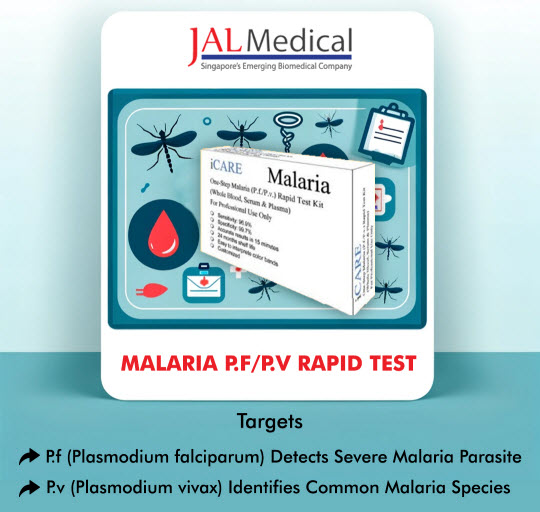Malaria, a mosquito-borne disease caused by Plasmodium parasites, continues to claim hundreds of thousands of lives annually, primarily in tropical and subtropical regions. Timely and accurate diagnosis is essential for effective treatment and prevention of further spread. Among the many diagnostic tools available, the WHO PQ Listed Malaria AG pLDH/HRP2 Test Card has emerged as a globally trusted solution. This diagnostic tool ensures accuracy, reliability, and ease of use, contributing significantly to malaria control efforts worldwide.
But what does “PQ-listed” mean, and why does it matter? This article explores the significance of WHO prequalification, the unique features of this test card, and its role in the fight against malaria.
What is WHO Prequalification (PQ-Listed)?
WHO Prequalification (commonly abbreviated as PQ-listed) is a certification process established by the World Health Organization to ensure that medical products meet the highest global standards of quality, safety, and efficacy. This process is particularly important for products intended for use in low-resource or high-disease-burden regions.
For diagnostic tools like the Malaria AG pLDH/HRP2 Test Card, prequalification means the product has undergone rigorous evaluations by WHO. These evaluations test the product’s performance under real-world conditions, ensuring its reliability in diverse healthcare environments.
Products that receive this certification are endorsed for use in both public health programs and international procurement initiatives, such as those led by UNICEF, the Global Fund, and non-governmental organizations.
Why WHO Prequalification Matters
- Global Standardization: PQ-listed products adhere to internationally recognized standards, ensuring uniform quality and reliability across regions.
- Confidence in Results: Healthcare providers can trust that PQ-listed diagnostic tools deliver accurate and consistent results.
- Enhanced Accessibility: Prequalification facilitates the distribution of critical health tools to the regions that need them the most, ensuring that even remote communities benefit.
- Trust for Manufacturers: For suppliers, being PQ-listed enhances their credibility, making their products the preferred choice for global health initiatives.
In the case of the WHO PQ-Listed Malaria AG pLDH/HRP2 Test Card, this designation assures healthcare providers and governments that they are using a trusted, high-quality diagnostic tool.
What is the WHO PQ-Listed Malaria AG pLDH/HRP2 Test Card?
The Malaria AG pLDH/HRP2 Test Card is a rapid diagnostic test (RDT) designed to detect malaria antigens in human blood. WHO PQ Listed Malaria PF Rapid Test is especially effective in identifying histidine-rich protein 2 (HRP2), specific to Plasmodium falciparum, and plasmodium lactate dehydrogenase (pLDH), which is present in all malaria species. This dual-detection capability ensures that the test is suitable for diagnosing multiple malaria types, including mixed infections.
The test card is prequalified by WHO, meaning it has been rigorously assessed and meets the organization’s stringent quality benchmarks. This makes it ideal for use in resource-limited settings, where quick, reliable diagnosis is essential for saving lives.

Key Features of the Malaria AG pLDH/HRP2 Test Card
The WHO PQ-Listed Malaria AG pLDH/HRP2 Test Card is highly regarded for its reliability and ease of use. Its features include:
- Dual Antigen Detection: The ability to detect both HRP2 (specific to P. falciparum) and pLDH (common to all malaria species) makes this test versatile and comprehensive.
- High Sensitivity and Specificity: Even in cases of low parasitemia, the test card delivers accurate results, minimizing false negatives and false positives.
- Rapid Results: The test provides results in just 15–20 minutes, allowing healthcare providers to initiate treatment immediately.
- Ease of Use: Designed for simplicity, the test card can be used with minimal training, making it accessible even in rural or remote areas.
- Portability: Lightweight and compact, it is perfect for fieldwork and mobile health clinics.
These features make the test card indispensable for malaria detection in endemic regions and beyond.
How the Test Card Works
Using the Malaria AG pLDH/HRP2 Test Card is straightforward, making it ideal for use in diverse settings, from urban clinics to rural health posts. Here’s how the process of WHO PQ Listed Malaria PF Rapid Test works:
- Sample Collection: A small blood sample is obtained using a finger prick.
- Application: The blood is applied to the test card, along with a few drops of buffer solution included in the kit.
- Antigen Detection: The card reacts to the presence of HRP2 and pLDH antigens in the sample.
- Result Interpretation: Results are displayed within minutes:
- One line indicates a negative result.
- Two lines indicate a positive result for malaria.
The simplicity of this process allows for quick decision-making and rapid initiation of treatment, which is critical in malaria management.
Advantages of Using the WHO PQ-Listed Malaria AG pLDH/HRP2 Test Card

The Malaria AG pLDH/HRP2 Test Card offers several benefits over traditional diagnostic methods:
In comparison to other diagnostic tools, this WHO PQ Listed Malaria PF Rapid Test combines affordability with precision, making it a preferred choice for governments and healthcare providers alike.
Role of Malaria Antigen Detection: HRP2 and pLDH
The Malaria AG pLDH/HRP2 Test Card is effective because it targets two key malaria antigens:
- HRP2 (Histidine-Rich Protein 2): Specific to Plasmodium falciparum, HRP2 is a reliable marker for diagnosing the most severe form of malaria.
- pLDH (Plasmodium Lactate Dehydrogenase): Present in all malaria species, pLDH allows for the detection of non-falciparum malaria and mixed infections.
This dual-targeting capability ensures comprehensive and accurate diagnosis, a crucial factor in reducing malaria mortality rates.
Conclusion
The WHO PQ-Listed Malaria AG pLDH/HRP2 Test Card is a game-changer in the fight against malaria. Its rapid, reliable, and easy-to-use design makes it invaluable for healthcare providers working in malaria-endemic regions. By adhering to WHO prequalification standards, this WHO PQ Listed Malaria PF Rapid Test ensures quality and trust, helping save lives and contributing to global malaria eradication goals.

